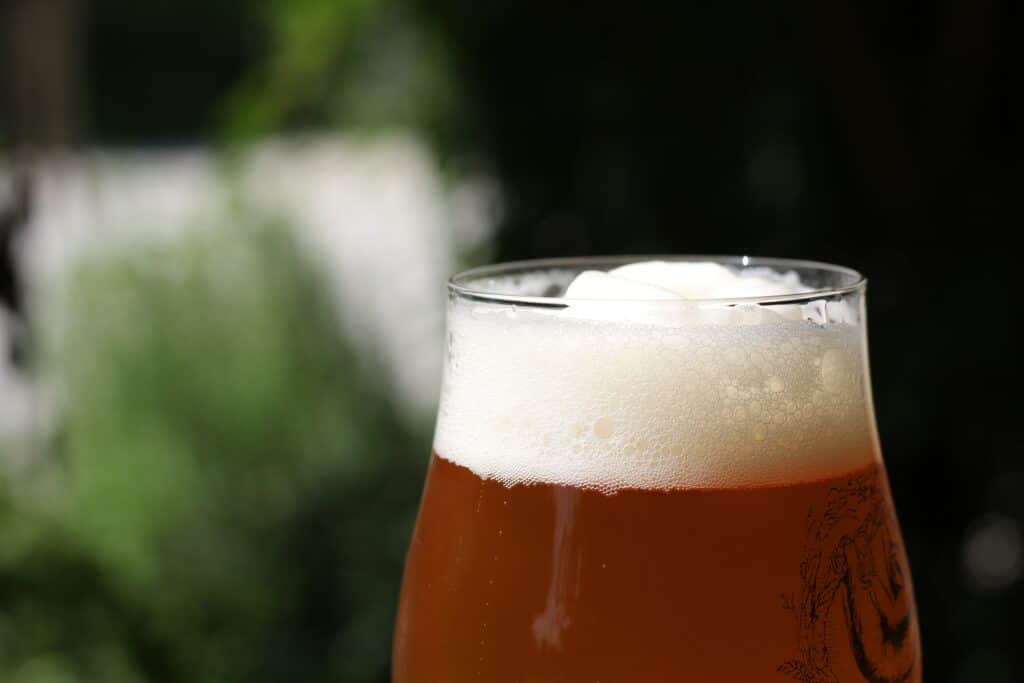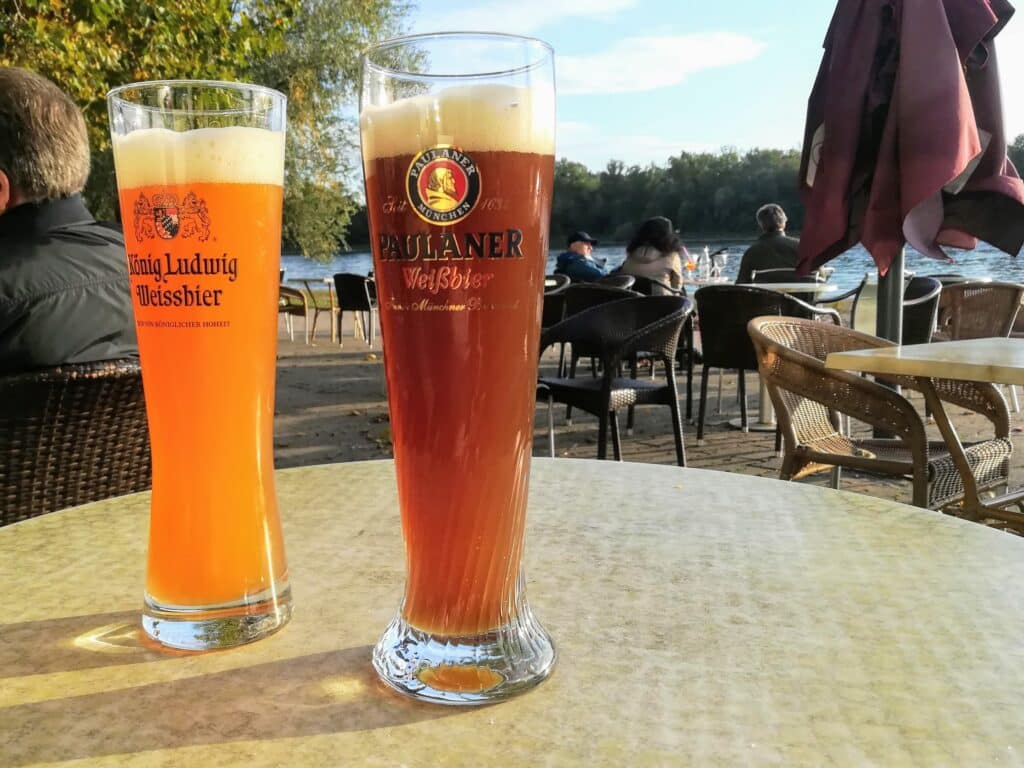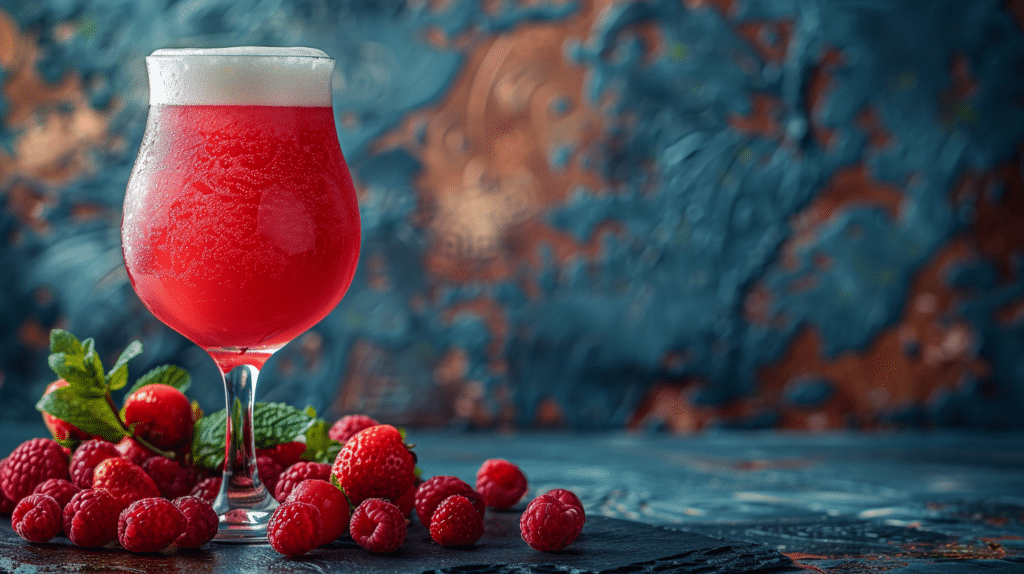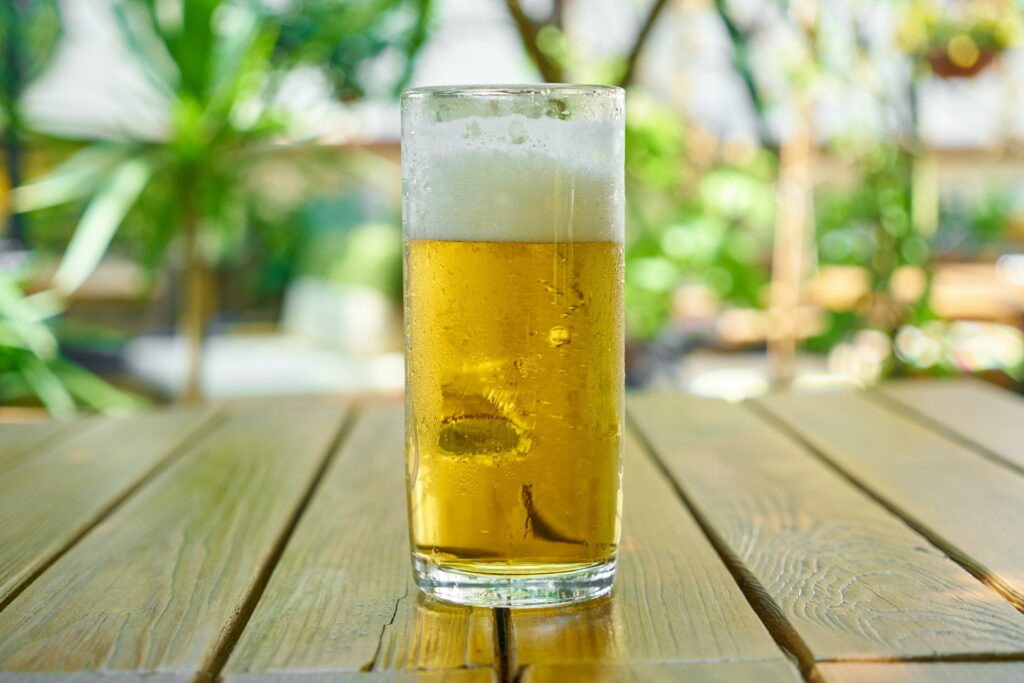Disclaimer: This post may contain affiliate links, from which I may earn a small commission at no extra cost to you. Thank you for supporting Ale Affair.
Everyone likes good head, right? The Europeans especially love theirs extra frothy. But why does beer have foam? Didn’t think that was where I was going? Well, if you’re still interested in why beer is foamy, the worldwide preference for the foam, and how to pour the perfect pint, then you’re in luck as this article ticks those boxes.
Why Does Beer Have Foam?
Beer foam is primarily formed by releasing carbon dioxide (CO2) gas when the beer is poured into a glass. Several factors influence this process.
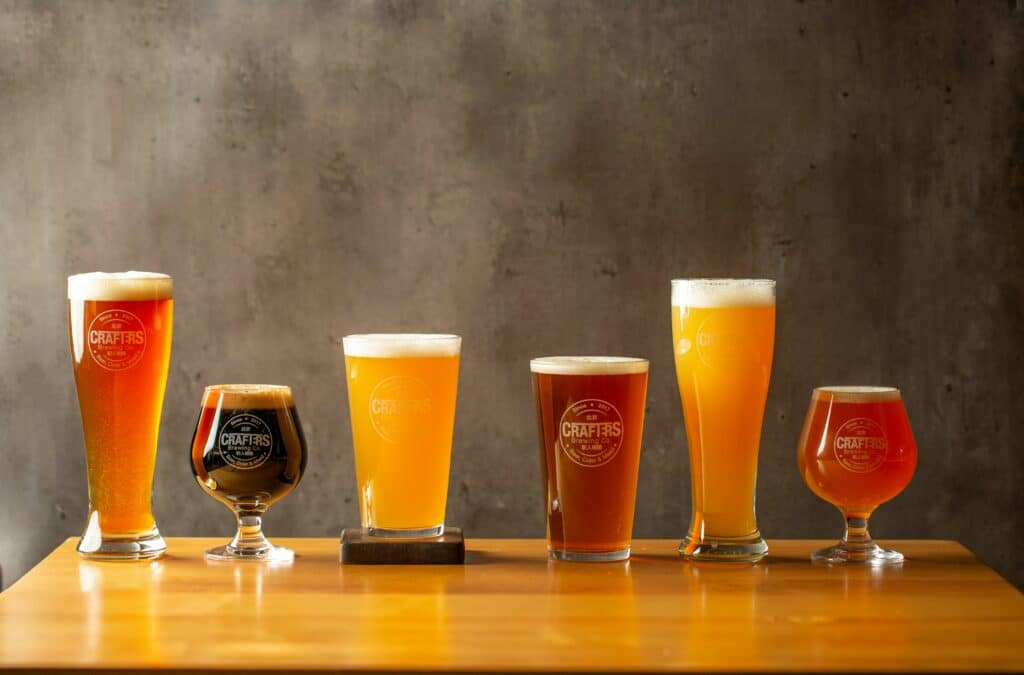
Carbonation
Beer is carbonated, meaning that CO2 is dissolved in it under pressure. When you pour beer into a glass, the pressure is released, causing the CO2 to come out of solution and form bubbles. These bubbles rise to the surface and create foam.
Proteins and Polysaccharides
The malt in beer contains proteins and polysaccharides (a carbohydrate whose molecules consist of sugar) that contribute to the formation and stability of the foam. These compounds act as surfactants, lowering the surface tension of the liquid and stabilising the bubbles in the foam by forming a film around them.
Hops
Hops, which are used to add bitterness, flavour, and aroma to beer, also contribute to foam stability. Compounds in hops, specifically iso-alpha acids, are good at stabilising foam by reinforcing the bubble walls.
Pouring Technique and Glassware
The way beer is poured and the type of glassware used can significantly affect the amount of foam. A pour that introduces more agitation (like pouring from a height or tilting the glass) will usually create more foam. Glassware designed with etchings at the bottom can also promote more bubble formation.
Temperature and Pressure
The temperature of the beer and the pressure at which it’s served can also influence foam formation. Colder beer can hold more CO2 in solution, so as it warms up, more gas can be released, potentially creating more foam. Similarly, beer served under higher pressure will release more CO2 when that pressure is reduced.
What Is Beer Foam Called?
Beer foam is commonly called the “head” of the beer. The head is made up of bubbles that form on the beer’s surface when it’s poured. The appearance, stability, and thickness of the head can vary widely among different types of beer, and it’s often considered an essential aspect of the beer’s presentation and flavour profile. The head can trap the beer’s aromas, enhancing its scent and overall taste experience.
Beer Heads Worldwide
Beer head preferences and sizes differ across the world, just like many other things. For example, Europeans tend to like a thicker head of foam on their beer, as they appreciate its aroma and texture. The British, on the other hand, prefer less foam and focus more on the ale itself. Meanwhile, Americans tend to prefer minimal foam, as they value having a full glass of beer. These preferences are influenced by the brewing traditions of each culture. Would you like to go on a trip to explore these differences further?
The European Foam Affinity
When considering European beer culture, it’s impossible to overlook their affinity for good head, and I’m not talking about Amsterdam (too crude?)
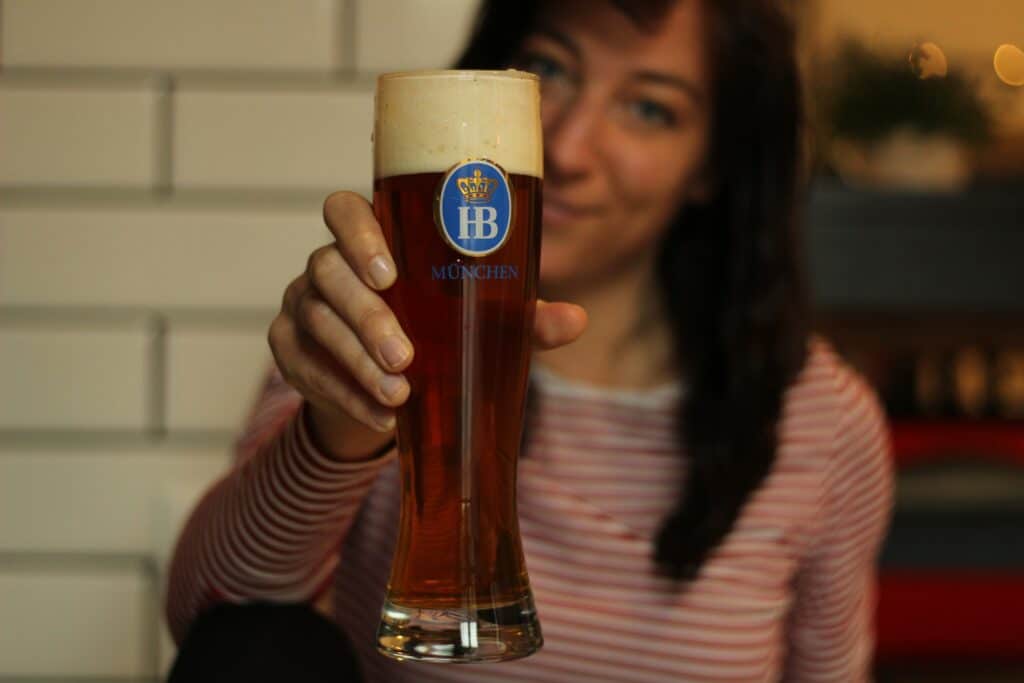
First, the foam enhances the beer’s aroma, a significant factor in how we taste. It’s akin to a flavour preview, teasing your senses with the brew’s unique bouquet even before you take your first sip.
Second, a generous head of foam signifies a well-kept beer served at the right temperature. In the bustling beer halls of Germany and the cosy pubs of Belgium, a proper pour is a mark of respect towards the brewer’s craft. A good 2-3 cm of foam is considered standard, a testament to the beer’s quality and the bartender’s skill.
Moreover, it’s worth noting that the type of beer influences the foam expectation. European beers like Belgian ales or German lagers often have high protein content and substantial carbonation, naturally producing a thicker, longer-lasting foam. It’s part of the beer’s identity, and it’s cherished as such.
The British Preference for Less Foam
Crossing the English Channel, we enter the kingdom of British beer culture, where pints are served with slightly less foam and more ale. This preference isn’t about being contrary to the Europeans; it reflects the UK’s distinct beer style and pub traditions.
British beer, often served as ales, stouts, and bitters, is known for its smooth, rich texture and complex flavours. These brews are typically less carbonated than their European counterparts and, thus, naturally produce less foam. Additionally, British beer is often dispensed via hand pumps, also known as cask or real ale, resulting in a more subdued head.
Yet, the lack of foam doesn’t mean a lack of flavour or quality. Quite the contrary, the less frothy top allows for a fuller pint, a fact appreciated by Brits who value their beer by volume. For us, it’s about getting the most out of our chosen pint without the foam taking up valuable space, heaven forbid!
American Aversion to Excessive Foam
Shifting our gaze towards the United States, we find another distinct perspective on beer foam. Like us Brits, Americans often favour their beers with little to no foam. Yet, this preference is tied to different cultural and historical factors.
American beer culture has been significantly influenced by the mass production of lagers since the late 19th century. This style of beer, especially the ones produced on a large scale, often has less foam due to lower carbonation levels.
The cultural expectation of getting a full glass of beer with minimal foam also traces back to the era of Prohibition. When alcohol was illegal, the quality drastically dropped, and excessive foam was seen as a way to disguise inferior-quality beer.
Ultimately, the American aversion to excessive foam on beer is rooted in historical factors such as mass lager production and Prohibition. The foam is often seen as taking up space that could be filled with more beer.
How To Pour The Perfect Beer
Pouring the perfect beer is an art that enhances its flavour, aroma, and appearance. Here’s a step-by-step guide to achieving that ideal pour, whether you’re using a bottle, can, or tap:
1. Choose the Right Glass: Use a clean glass appropriate for the beer style. Different shapes can enhance the specific characteristics of various beer types.
2. Rinse the Glass: A quick rinse with cold water can chill the glass, remove dust, and reduce friction to help achieve a better pour.
3. Start with an Angle: Hold the glass at a 45-degree angle. This technique reduces the impact when the beer hits the glass, controlling the initial foam creation.
4. Pour Slowly: Begin pouring the beer, targeting the middle of the slope of the glass. Pouring too fast can create too much foam, while too slow can result in a flat beer.
5. Straighten and Fill: When the glass is about half full, slowly straighten it to a 90-degree angle and continue pouring in the centre to create the ideal head. Aiming for about 1 to 1.5 inches (2.5 to 3.8 cm) of head is a good rule of thumb for most beers.
6. Control the Head: Adjust the distance between the bottle/can/tap and the glass to control the size of the head. Closer pours reduce the head while pouring from higher up increases it.
Additional Tips:
- Temperature Matters: Serve beer at the appropriate temperature for its style. Some beers are better warmer, while others are best served cold.
- Pouring from a Tap: If using a draft system, open the tap fully and quickly to avoid a foamy pour. The principles of angling the glass and straightening it apply here as well.
- Pouring Nitro Beers: Beers with nitrogen (like Guinness) often require a more aggressive pour directly into the centre of the glass to activate the nitrogen cascade effect, creating a creamy head.
Summary
Beer foam, known as the “head,” is created by releasing carbon dioxide when beer is poured, influenced by carbonation, proteins, polysaccharides, hops, pouring technique, and temperature. In Europe, a substantial head is preferred for enhancing aroma and indicating quality, with traditions varying by region. British and American beer cultures often favour less foam, reflecting their brewing styles and historical preferences. Pouring the perfect beer involves choosing the right glass, rinsing it, starting with an angle, pouring slowly, straightening the glass, and controlling the head’s size, aiming for about 1 to 1.5 inches to enhance flavour and aroma. And I wrote all that with minimal innuendos; let me know how you like your head!
FAQ
Is Beer Foam Wasted Beer?
If you pour a beer too quickly and it foams up excessively, some beer might be lost if the foam overflows the glass. However, if the foam stays within the glass and settles, you haven’t lost beer; it changes form temporarily before settling into liquid.
How does foam turn back into beer?
Foam turns back into beer as the bubbles burst, releasing the trapped carbon dioxide gas. This process causes the liquid components of the foam to coalesce and settle back into the beer, gradually transforming the foam into liquid form at the beer’s surface.
Is there alcohol in beer foam?
Yes, there is alcohol in beer foam. The foam is made from the same ingredients as the beer itself, including alcohol, so it contains alcohol in proportion to the liquid beer from which it’s formed.
Share Now!
Raise a glass to knowledge! Each article you share pours a little more wisdom into the world, frothing with ideas and bubbling with insights.
